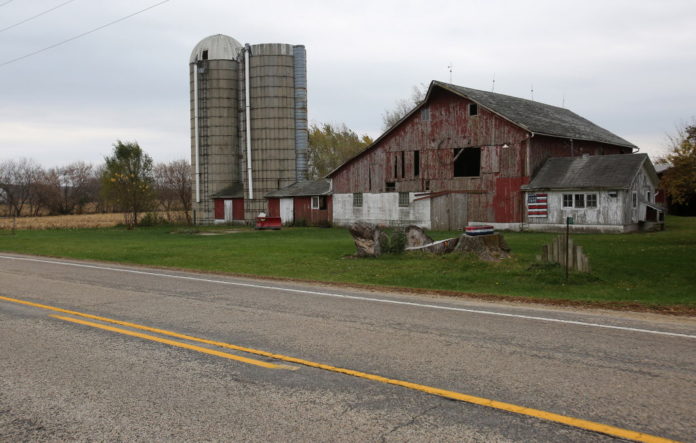Wisconsin’s farm groups agree that more than $850 million in federal aid was needed to absorb the shock of COVID-19 in the ag sector, but trade and market changes for the long-term success of the industry are also critical.
When COVID-19 hit Wisconsin, it shut down schools, restaurants and hotels, and limited travel — big-ticket markets for the state’s agriculture industry. Not only that, but the supply chain for farm products was challenged as processing plants shut down due to virus outbreaks among workers.
The Trump administration launched two rounds of the Coronavirus Food Assistance Program. This provided producers with financial assistance to absorb the increased marketing costs associated with the pandemic. Additionally, Gov. Tony Evers allocated $50 million of the state’s share of federal CARES Act money to the Wisconsin Farm Support Program.
But COVID-19’s impact was just further strain on an already weak agricultural economy. Wisconsin’s farming organizations say farmers are looking for long-term relief to deal with the effects of trade wars, low prices, unpredictable markets and bankruptcies that existed prior to the pandemic.
“Something that we hear over and over from farmers across the political spectrum is that they would rather get a fair price from the marketplace than accept government aid or rely on these programs to keep their farms afloat,” said Bobbi Wilson, policy and special projects coordinator for the Wisconsin Farmers Union. “Unfortunately, we’re in a situation right now where the aid is even more needed than it was before due to the supply chain disruptions and price volatility caused by the pandemic. But on the whole, farmers would just rather see fair and stable prices that they can count on rather than having to take a handout.”
WFU is currently advocating for a federal program to balance supply and demand across all commodities, including the dairy industry. Wilson highlighted two main issues that drive low prices and an unstable farm economy: oversupply and consolidation.
“We’re seeing fewer and fewer farms of much larger size, and those farms are able to pump out a lot more food at a much lower price than some of our small and medium-sized farms,” she said. “These two issues together really just drive or accelerate this trend toward fewer farms of much larger scale.”
Wilson argued that programs balancing supply and demand would level the playing field for farmers and help raise and stabilize commodity prices.
“And then similarly, if we had stronger antitrust enforcement and had aid and farm bill programs distributed more fairly, then we wouldn’t be prioritizing the largest farms at the expense of small and medium-size operations,” she said.
She cited that nationally, 20 percent of the money from the first round of federal payments went to the top 1 percent of farms. Meanwhile, the bottom 10 percent of farms received 0.26 percent of the money.
The Trump administration’s checkbook had a strong focus on the Midwest as this year marked record federal payments to farmers tied to COVID-19 relief efforts. These funds will support the farm income in 2020, according to the University of Missouri’s Food and Agricultural Policy Research Institute.
For CFAP 1, Wisconsin was behind Iowa, Nebraska, California, Minnesota and Texas in the amount of money received. The state accounted for 2.9 percent of applications and 5.1 percent of all the dollars, bringing in over $524 million of roughly $10.3 billion. The application period for CFAP 1 ended on September 11.
As of Oct. 18, Wisconsin follows Iowa, Illinois, Nebraska and Minnesota for federal dollars received. Farmers account for 3.5 percent of applications and 5.4 percent of the money, raking in over $330 million so far. The application period for the second round closes Dec. 11.
“It does seem that the aid that’s coming is well-timed with the election, and as we’ve seen the way that some of the payments have been distributed from trade programs and other things, it does tend to go towards counties that historically have voted for the president,” Wilson said.
She said she doesn’t know whether WFU members will factor recent federal aid in their voting decisions.
“The money is nice, but I think there is still this sense of guilt of having to take the money at all,” she said. “I think that farmers would prefer to see a president who’s going to prioritize long term stability over short term handouts.”
Wisconsin Corn Growers President Doug Rebout said farmers may be looking at the whole picture, not just the care packages, come Election Day.
“For some farmers, it may help sway decisions. But I’m sure there’s some other farmers that are saying just the opposite: ‘Well, if he would’ve done something else, we wouldn’t have needed this,” he said.
Rebout said the federal dollars keep farmers viable and going, but he views the money as putting a Band-Aid on the issues farmers are and have been facing.
“Yes, it’s helping us,” he said. “But what we need to do is keep going, working on the future, and our trade deals, and our research and everything, so that way in the future, we don’t need to worry about packages like this — that we can get paid for our product.”
The Wisconsin Corn Growers are looking for trade, Rebout said. The organization is pushing for opening new markets with other countries in addition to strengthening relationships with China, Mexico and Canada.
“As farmers, we just want to get paid a proper price for our product. We’re not out looking to get rich or anything, we want to be able to pay our bills, support our families and to continue a tradition that we all grew up in,” he said.
Tyler Wenzlaff, the national affairs coordinator for the Wisconsin Farm Bureau Federation, said that the bipartisan, federal dollars were a necessary step to stop the agriculture industry from falling apart.
He explained the pandemic proved a consumer dependence on an on-time delivery food system and that any mistake or change in a product’s route from farm to table “sets the whole system out of whack, and it’s difficult to find the balance again.”
Wenzlaff said he’s unsure what the system will look like coming out of the pandemic. But as consumers slowly trickle back into their normal buying habits, they’re more in tune with where their food is coming from.
“Confidence in farmers is at an all-time high,” he said. Wenzlaff added that the Farm Bureau continues to advocate for open markets, open trade and an on-time functional supply chain.
“We hope that our elected officials will continue to keep agriculture at their forefront when making decisions going forward,” he said.
-By Stephanie Hoff
WisBusiness.com






